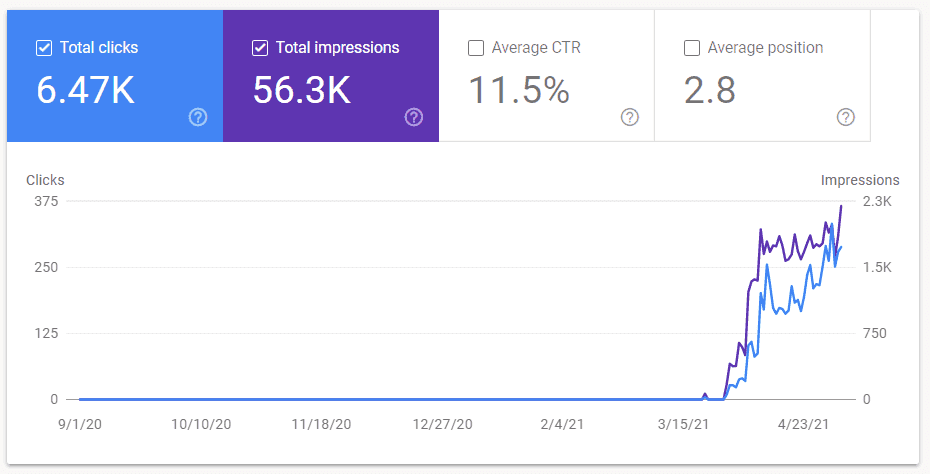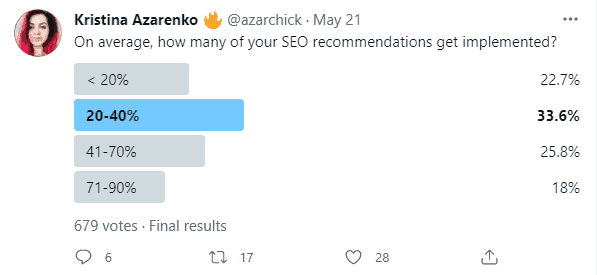Climbing up the SERP for competitive keywords that will drive qualified organic traffic to your site is no easy feat in 2021. Having a solid, data-driven strategy is a must. There’s simply no question about it.
It’s a great feeling when clients agree with your recommendations straight away; however, sometimes it takes a little effort and patience for them to say yes. And, in some cases, recommendations will never actually be approved and/or implemented.
In Krisitina Azarenko’s recent twitter poll with nearly 700 votes, it was revealed that over half of SEO’s have less than 40% of their recommendations implemented.
On average, how many of your SEO recommendations get implemented?
— Kristina Azarenko ???? (@azarchick) May 20, 2021
Hold up, only 18% of SEOs have 71-90% of their recommendations implemented?!
Whether you work for an agency, freelance or in-house, you’ll need to get buy-in from your clients when it comes to executing and implementing large-scale SEO strategies and optimization recommendations.
This article will look at some of the things you need to consider when it comes to getting that all-important thumbs-up from a client.
Why are clients reluctant to sign off on SEO strategies?
To understand how to get client buy-in, it helps to know why some clients may waver on approving your SEO strategy.
Multiple Parties Are Often Involved In Cross-functional Settings
When you’re presenting your strategy, it’s highly unlikely you’ll be pitching to just one person. Instead, you’ll be showcasing your proposal to multiple departments in a company, often with their own goals and intentions.
For example, your strategy may need to be signed off by not only the marketing team, but product managers, dev, and legal. This may make getting that ‘yes’ a little bit trickier.
To increase the odds of your strategy being approved, you need to understand the reservations and legitimate concerns each department may have.
Could the product team be concerned that a proposed new page on the website be off-brand, and not fully aligned with their strategy? Absolutely. Could the UX team fear that their layout designs will be compromised? 100%.
Listen to each other. Understand each other. Collaborate together, and succeed together.
People Don’t Like Change
“We’ve always done it this way, but let’s change it up!” Said no one ever.
Sometimes people have an “if it ain’t broke, don’t fix it” approach to business. This can have a significant impact on why so many initiatives fail to get rubber-stamped.
So, why do people start to panic when change is mentioned?
- They feel change will result in a loss of control
- They’re happy with the way things are going
- They worry that the new changes will result in a bigger workload for them and their team
- They have a fear of the unknown and don’t understand the changes you propose (we’ll go into more detail about this later)
If you want to win over a client who is unsure whether your optimization recommendations are the best option, take the time to explain the benefits your SEO strategy will bring to the table. Model out what success could look like.
Transforming your thought process, data analysis, and business-impact models into digestible and shareable presentations will help get your optimization recommendations expedited.
And that leads into the next point…
Clients Just Aren’t Sure What SEO Really Is
When you work in SEO, you generally tend to live, sleep and breathe website optimization.
You’re on top of the most recent Google algorithm updates, you understand the opportunities, impact, and implications of different SERP features, you’re always pointing out the great and the not so great practices of your competitors, and you’re connected to all the thought leaders on LinkedIn.
However, your clients probably aren’t as knowledgeable in SEO as you are, and that’s okay. In fact it’s more than okay. That’s why you were brought on in the first place.
Although many people have a basic understanding of SEO and what it is, they will not have the comprehensive knowledge that you do. If they can’t understand what you are planning to achieve, they are unlikely to say yes to your proposal.
The best way to get your clients on board when it comes to SEO is to break things down as simply as possible for them. Try to avoid jargon and SEO jokes in your pitch, and take the time to explain the different concepts and how they will benefit your client.
If your recommendations involve noticeable visual changes to a page, make a mock-up.
If you want to see more SEO-focused, keyword-driven blog posts – create the blog outlines and ask if they can be integrated into the content calendar.
Show your clients what SEO is. Taking the time to walk through important concepts related to your strategy and recommendations is crucial.
Remember to Pivot When Needed
It’s no question that at some point during an SEO campaign, for many reasons, you may need to pivot your strategy. If you are proposing changes, remember that knowledge is power. Give your client as much information as possible to help them make an informed decision.
- What exactly are you proposing?
- How much time will it take to carry out?
- What is the level of effort?
- What support will you need from the client?
- What are your goals, and what do you expect to achieve?
- How will you report back on the changes made?
Three Examples of How Successful Client Buy-in Led to Significant Results
Getting client-buy in can be a challenge. However, taking the effort to get the right people on your side can lead to amazing results.
Here are three fantastic examples of campaigns where a little groundwork at the beginning led to everyone reaping the benefits.
1) Local SEO: Google My Business Reviews
Optimizing your Google My Business (GMB) listing/s is crucial to Local SEO efforts. A well optimized listing can lead to increased visibility In Google Search and Google Maps for local intent-driven searches. Subsequently, there is a greater chance for the user to perform an action such as click on the “get directions” button or visit the business’s website.
Velocity, quantity, and quality of reviews left are all important factors for Local SEO.
Not every SEO initiative needs to reinvent the wheel. Most businesses already have tools in place to get valuable feedback from their customers. it’s often easier for your SEO recommendation to be accepted if the infrastructure already exists.
Understanding who the stakeholders are, as well as their concerns, is crucial for getting universal buy-in. The marketing team may be thrilled to get more GMB reviews but they don’t necessarily have to deal with responding to them. If you’re working with an enterprise-level business, that could mean responding to thousands of new reviews a day. When met with logistical resistance like this, it can pay off to suggest testing your initiative first. Just look at the graph below. The green line is the number of reviews that a business’s GMB profile received following A/B testing. The blue line is the average rating of the reviews received (on a scale from one star to five stars).

After the GMB review acquisition campaign for one of Kahena’s enterprise clients was executed, the number of reviews received weekly shot up, from 600 a week to 2,200 a week. Not only this, but the rating of the business increased too, from 3.5 to just under four. After it was established that the strategy worked, buy-in was assured and the project scaled-up to 100% of the thousands of locations.
Sometimes the smallest changes can lead to the biggest results. If you’re looking to get buy-in from clients, start small. When they see the results, they’ll be incentivized to let you try larger projects.
2) B2B SEO: SEO-Driven Landing Pages
It’s only natural that a client may be hesitant about changes made to their website. As a result, there may be a lot of ‘what if’s’ running through their head:
What if this project fails and I have to explain it to my manager or the board?
What if leads and conversions nosedive and sales fall?
What if something goes wrong and it takes time and money to put things back to the way it was before.
In this example of creating new SEO-driven landing pages for a client, they were initially hesitant about our strategy, largely due to the target keywords being slightly off-brand. After walking through the positive impact that the recommendations would have for increasing organic traffic, the client approved and implemented the recommendations. As seen in the Google Analytics screenshot below, these recommended pages ended up bringing in a relatively significant amount of organic traffic.

After implementation, the importance of showing your client how things are improving is a must. Let them know how progress is being made on a daily, weekly or monthly basis. That way, they can see what impact the amends you have made are making over time, giving them the reassurance they need.
3) B2C Ecommerce: SEO-Driven Thematic Pages
When a client launches a new product or service, they want to be sure that the SEO strategy you are carrying out has an impact and will lead to increased traffic, and conversions.
Here’s an example of a successful SEO campaign for a product relaunch. Initially, a client believed that there was enough content on the website to rank for long-tail search around the product. However, after SERP analyses for various keywords, a new thematic page was recommended and created to promote the new product, to specifically target long-tail keywords. As seen, impressions and clicks to the page rapidly grew over the space of just a few weeks, leading to additional incremental revenue.

Wrapping Up
Trying to get your clients on board when attempting to execute large-scale SEO strategies can be a challenge. It’s really not as simple as rocking up, telling them what you want to do and asking for sign-off.
Here are some sure-fire tips to encourage buy-in:
- Customise your pitch to the people and departments you are collaborating with
- Work with advocates who can help promote your vision
- Relay the benefits that your strategy can bring to the business
- Break down complex concepts and avoid the SEO gibberish
A little preparation and research will go a long way. When strategies are executed and implemented correctly, the results are seen and appreciated by all.


